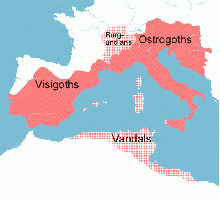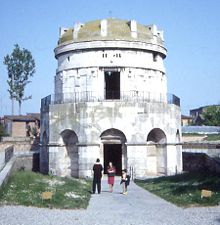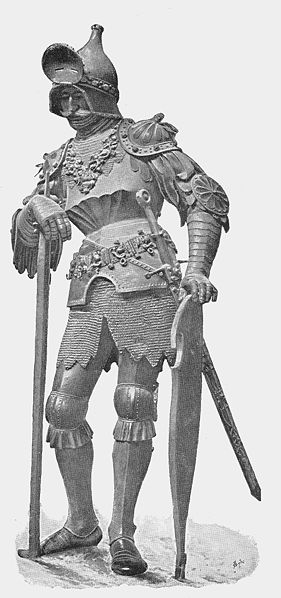Theodoric the Great
Theodoric the Great (454 – August 30, 526), known to the Romans as Flavius Theodoricus, was king of the Ostrogoths (471-526),[1] ruler of Italy (493–526), and regent of the Visigoths (511–526). He became a hero of Germanic legend as Þeodric in English legends, Dietrich von Bern in German legends and as Þjóðrekr and Þiðrekr in Norse mythology. During his reign, Theodoric succeeded in bringing together the Roman and Gothic peoples in relative harmony. While he allowed the Romans to practice their own customs and laws, he simultaneously was able to increase Gothic settlement in the area. Theodoric initiated several internal improvements to address the condition of the kingdom's roads and waterways, as well.[2] Near the end of Theodoric's reign however, disharmony had begun to set in. Theodoric the Great lived at a time when the old order in Western and central Europe, represented by the Roman Empire was ending and the new order, launched by the establishment of the Holy Roman Empire under Charlemagne of the Frankish Empire had not yet started.
Different polities, including the continuing Eastern Roman Empire, were competing and Theoderic trod on this historical stage. His respect for Roman customs enabled their survival at a time of swift change, so that when the new order was launched, Roman law and Roman administrative practice continued to give order to life across the semi-independent polities that constituted what became the Holy Roman Empire. He bore title of Consul of the Roman Empire from 484. Theodoric played a significant role in helping to preserve, and pass on, the legacy of the Classic Age. His polity did not survive long after his death, when ascendancy passed to the Frankish Empire from which the Holy Roman Empire emerged. However, his legacy represented no insignificant contribution to the shape that the future polity would take.[3]
Youth
The man who ruled under the name of Theodoric was born in 454 on the banks of the Neusiedler See near Carnuntum, a year after the Ostrogoths had thrown off nearly a century of domination by the Huns. The son of the King Theodemir and Erelieva, Theodoric went to Constantinople as a young boy, as a hostage to secure the Ostrogoths' compliance with a treaty Theodemir had concluded with the Byzantine Emperor Leo.
He lived at the court of Constantinople for many years and learned a great deal about Roman government and military tactics, which served him well when he became the Gothic ruler of a mixed but largely Romanized people. Treated with favor by the Emperors Leo I and Zeno, he became magister militum (Master of Soldiers) in 483, and one year later he became consul. He afterwards returned to live among the Ostrogoths when he was 31 years old, and became their king in 488.
Family and issue
Theodoric was married once. He had a concubine in Moesia, name unknown, and had two daughters:
- Theodegotha (c. 473– ?) In 494, she was married to Alaric II as a part of her father's alliance with the Visigoths.
- Ostrogotha or Arevagni (c. 475– ?) In 494 or 496, she was married to the king Sigismund of Burgundy as a part of her father's alliance with the Burgundians.
Married to Audofleda in 493, and had one daughter:
- Amalasuntha, Queen of the Goths. She was married to Eutharic and had two children: Athalaric and Matasuentha (the latter being married to Witiges first, then, after Witiges' death, married to Germanus Justinus, neither had children). Any hope for a reconciliation between the Goths and the Romans in the person of a Gotho-Roman Emperor from this family lineage was shattered.
Reign
At the time, the Ostrogoths were settled in Byzantine territory as foederati (allies) of the Romans, but were becoming restless and increasingly difficult for Zeno to manage. Not long after Theodoric became king, the two men worked out an arrangement beneficial to both sides. The Ostrogoths needed a place to live, and Zeno was having serious problems with Odoacer, the King of Italy, who had overthrown the Western Roman Empire in 476. Ostensibly a viceroy for Zeno, Odoacer was menacing Byzantine territory and not respecting the rights of Roman citizens in Italy. At Zeno's encouragement, Theodoric invaded Odoacer's kingdom.
Theodoric came with his army to Italy in 488, where he won the battles of Isonzo and Verona in 489, and at the Adda in 490. In 493, he took Ravenna. On February 2, 493, Theodoric and Odoacer signed a treaty that assured both parties would rule over Italy. A banquet was organized in order to celebrate this treaty. It was at this banquet that Theodoric, after making a toast, killed Odoacer with his own hands.[4]
Like Odoacer, Theodoric was ostensibly only a viceroy for the emperor in Constantinople. In reality, he was able to avoid imperial supervision, and dealings between the emperor and Theodoric were as equals. Unlike Odoacer, however, Theodoric respected the agreement he had made and allowed Roman citizens within his kingdom to be subject to Roman law and the Roman judicial system. The Goths, meanwhile, lived under their own laws and customs. In 519, when a mob had burned down the synagogues of Ravenna, Theodoric ordered the town to rebuild them at its own expense.
Theodoric the Great sought alliances with, or hegemony over, the other Germanic kingdoms in the west. He allied with the Franks by his marriage to Audofleda, sister of Clovis I, and married his own female relatives to princes or kings of the Visigoths, Vandals and Burgundian. He stopped the Vandals from raiding his territories by threatening the weak Vandal king Thrasamund with invasion, and sent a guard of 5,000 troops with his sister, Amalfrida, married Thrasamund in 500. For much of his reign, Theodoric was the de facto king of the Visigoths as well, becoming regent for the infant Visigothic king, his grandson Amalric, following the defeat of Alaric II by the Franks under Clovis in 507. The Franks able to wrest control of Aquitaine from the Visigoths, but otherwise, Theodoric was able to defeat their incursions.
Thedoric's achievements began to unravel even before his death. He had married his daughter Amalasuntha to the Visigoth Eutharic, but Eutharic died in 522 or 523, so no lasting dynastic connection of Ostrogoths and Visigoths was established. In 522, the Catholic Burgundian king Sigismund killed his own son, Theodoric's grandson, Sergeric. Theodoric retaliated by invading, probably in 523, annexing the southern part of the Burgundian kingdom. The rest was ruled Sigismund's Arian brother Godomar, under Gothic protection against the Franks who had captured Sigismund. This brought the territory ruled by Theodoric to its height, but in 523 or 524, the new Catholic Vandal king Hilderic imprisoned Amalfrida, and killed her Gothic guard. Theodoric was planning an expedition to restore his power over the Vandal kingdom when he died in 526.
After his death in Ravenna in 526, Theodoric was succeeded by his grandson Athalaric. Athalaric was at first represented by his mother Amalasuntha, who was a regent queen from 526 until 534. The kingdom of the Ostrogoths, however, began to wane and was conquered by Justinian I starting after the rebellion of 535 and finally ending in 553 with the Battle of Mons Lactarius.
Legacy
Theodoric the Goth was neither Frank nor Hun. He had great respect for the Roman culture he saw himself as representing. He had an eye for outstanding talent. In about 520, the philosopher Boethius became his magister officiorum (head of all the government and court services). Boethius was a man of science, a dedicated Hellenist bent on translating all the works of Aristotle into Latin and harmonizing them with the works of Plato, not an easy task. Eventually Boethius fell out of favor with Theodoric, perhaps out of a suspicion that he was in sympathy with Justin, emperor of the East, for Arian Theodoric was always somewhat of an outsider among Nicaean Christians. Theodoric ordered Boethius executed in 525. In the meantime Cassiodorus had succeeded Boethius as magister in 523. The pliant historian and courtier could be counted on to provide refined touches to official correspondence. "To the monarch you [Cassiodorus] were a friendly judge and an honored intimate. For when he got free of his official cares he looked to your conversation for the precepts of the sages, that he might make himself a worthy equal to the great men of old. Ever curious, he wanted to hear about the courses of the stars, the tides of the sea, and legendary fountains, that his earnest study of natural science might make him seem to be a veritable philosopher in the purple" (Cassiodorus' letterbook, Variae 9.24.8). The gulf was widening between the ancient senatorial aristocracy whose center was Rome and the adherents of Gothic rule at Ravenna: other distinguished public figures followed Boethius to the block. Theodoric in his final years was no longer the disengaged Arian patron of religious toleration that he had seemed earlier in his reign. "Indeed, his death cut short what could well have developed into a major persecution of Catholic churches in retaliation for measures taken by Justin in Constantinople against Arians there."[5]
Theodoric was of Arian faith. At the end of his reign quarrels arose with his Roman subjects and the Byzantine emperor Justin I over the Arianism issue. Relations between the two nations deteriorated, although Theodoric's ability dissuaded the Byzantines from waging war against him. After his death, that reluctance faded quickly. Theodoric the Great was interred in Ravenna. His mausoleum is one of the finest monuments in Ravenna. For all the achievements made during his rule, he is considered the greatest of the Ostrogothic rulers.[6]
Legend
Theodoric was included into epic poetry as Dietrich von Bern, who is depicted as the archetype of the wise and just ruler. The Encyclopedia Britannica (1911) noted that "the legendary history of Dietrich differs so widely from the life of Theodoric that it has been suggested that the two were originally unconnected." Anachronisms abound, for example in making Ermanaric (died 376) and Attila (died 453) contemporary with Theodoric (born 454). Bern is the Middle High German form of Verona, which was one of the historical Theodoric's residences.
Dietrich figures in a number of surviving works, and it must be assumed that these draw on long-standing oral tradition. He first appears in the Hildebrandslied and the Nibelungenlied, in neither of which is Dietrich a central character, and other epics, which were composed or written down after 1250. In Scandinavia, he appears on the Rök Stone, carved in Sweden in the 800s, in Guðrúnarkviða II and III of the Poetic Edda and in Þiðrekssaga. He moreover appears in the Old English Waldere, Deor, and Widsith poems.
The earliest evidence of the legend is provided by the heroic lay, the Hildebrandslied, recorded in around 820. In this, Hadubrand recounts the story of his father Hildebrand's flight eastwards in the company of Dietrich, to escape the enmity of Odoacer (this character would later become his uncle Ermanaric). Hildebrand reveals that he has lived in exile for 30 years. Hildebrand has an arm ring given to him by the (unnamed) King of the Huns, and is taken to be an "old Hun" by Hadubrand. The obliqueness of the references to the Dietrich legend, which is just the background to Hildebrand's story, indicates an audience thoroughly familiar with the material. In this work Dietrich's enemy is the historically correct Odoacer (though in fact Theodoric the Great was never exiled by Odoacer), indicating that the figure of Ermaneric belongs to a later development of the legend.
In the heroic epic the Nibelungenlied (c. 1200), Dietrich is living in exile at the court of Etzel (Attila), the Hunnish King. He fights on Etzel's side against the Burgundians, and his whole retinue apart from Hildebrand is slain. He ends the conflict by capturing Hagen and then Gunther in single combat.
The Norse saga deals with Dietrich's return home. The most familiar version is that by an Icelandic or Norwegian author writing in Norway in the thirteenth century, who compiled a consecutive account of Dietrich, with many additional episodes. This Norse prose version, known as the Þiðrekssaga (Thidrek's saga), incorporates much extraneous matter from the Nibelungen and Weyland legends.
The late Heinz Ritter-Schaumburg reinspected the Old Swedish version of the Thidreks saga for the historical information it contained, and established its topographical accuracy. Further, he concluded that these oldest of the "Dietrich" sources cannot refer to Theodoric the Great of the Goths, whose movements are moderately well known, mainly because of irreconcilable topographical anomalies. Ritter-Schaumburg asserted that their narration relates instead to a contemporary of the famous Goth, who bore the same name, rendered Didrik in Old Swedish. Moreover, he identified Berne as Bonn to which was ascribed, in the medieval age, an alternative (Latinized) name Verona of unknown origin. According to Ritter-Schaumburg, Dietrich lived as a Frankish petty king in Bonn.[7] This theory has found much opposition by other scholars.[8]
Another modern author, Rolf Badenhausen, starts from Ritter-Schaumburg's approach but ends up with a different result. He claims Berne, where Thidrek/Didrik started his rise, to be identical with Varne, south of Aachen, the Roman Verona cisalpina, in the district of the northern Rhine/Eiffel lands. Thidrek/Didrik could be identified with Theuderich son of Clovis I, a royal Frank mentioned with approval by Gregory of Tours and in Fredegar's royal Frankish chronicle.
In the Book of Bern (Buch von Bern) written in the late thirteenth century partly by Henry the Fowler, Dietrich tries to regain his empire with the help of the Huns. In the collection of the Heldenbuch (Book of Heroes), Dietrich's story is related in Dietrichs Flucht (Dietrich's Flight), the Rabenschlacht (The Battle of Ravenna), and Alpharts Tod (Alphart's Death).
The legendary figure of Dietrich also appears in the thirteenth century Rosengarten zu Worms (Rosegarden at Worms), the Epos of Biterolf, of Goldemar, of Ecke, Sigenot and Laurin.
A fictionalized, but impressively researched, version of Theodoric's career is presented in Raptor, a novel by Gary Jennings.
| Preceded by: Theodemir |
King of the Ostrogoths 474–526 |
Succeeded by: Athalaric |
| Preceded by: Odoacer |
King of Italy 493–526 | |
| Preceded by: Anicius Acilius Aginatius Faustus, Post consulatum Trocundis (East) |
Consul of the Roman Empire 484 with Decius Marius Venantius Basilius |
Succeeded by: Q. Aurelius Memmius Symmachus, Post consulatum Theoderici (East) |
Notes
- ↑ Bernard Grun, The Timetable of History, 3rd edition (New York: Simon & Schuster, 1946, ISBN 0-671-74271-X).
- ↑ Infoplease, Theodoric the Great. Retrieved June 19, 2008.
- ↑ Cantor, p. 105-107.
- ↑ Hutton Webster, Ancient History (Boston: D.C. Heath & Co., 1913). Retrieved June 19, 2008.
- ↑ James J. O'Donnell, Cassiodorus (Berkeley, CA: University of California Press, ISBN 9780520036468).
- ↑ Christopher Kleinhenz, (ed.), Medieval Italy: An Encyclopedia (New York: Routledge, 2004, ISBN 0415939313). p. 1088.
- ↑ Heinz Ritter-Schaumburg, Dietrich von Bern. König zu Bonn (Munich/Berlin, DE: Herbig, 1982, ISBN 9783776612271).
- ↑ Henry Kratz, review of Die Nibelungen zogen nordwärts The German Quarterly, 56(4): 636-638.
ReferencesISBN links support NWE through referral fees
- Badenhausen, Rolf. Rolf Badenhausen, Merovingians by the Svava? badenhausen.net. Retrieved June 19, 2008.
- Cantor, Norman F. 1993. The Civilization of the Middle Ages. Harper Perennial. ISBN 0 06 092553 1.
- de Bracton, Nicolaa. Theodoric the Great. The Middle Ages. Retrieved June 19, 2008.
- Grun, Bernard. 1946 (1991). The Timetable of History, 3rd edition. New York: Simon & Schuster. ISBN 0-671-74271-X.
- Heather, Peter. 1996. The Goths. Oxford: Wiley-Blackwell. ISBN 0631209328.
- Hodgkin, Thomas. 1891 Theodoric the Goth. New York: G.P. Putnam's Sons. Retrieved June 19, 2008.
- Jennings, Gary. 1992. Raptor. New York: Doubleday. ISBN 9780385246323.
- Kleinhenz, Christopher (ed.). 2004. Medieval Italy: An Encyclopedia. New York: Routledge. ISBN 0415939313.
- Knight, Kevin. Catholic Encyclopedia: Theodoric the Great. Retrieved June 19, 2008.
- Kratz, Henry. 1983. Review of "Die Nibelungen zogen nordwärts," by Heinz Ritter-Schaumburg. The German Quarterly. 56(4): 636-638.
- Moorhead, John. 1992. Theoderic in Italy. Oxford: Oxford University Press. ISBN 0-19-814781-3.
- O'Donnell, James J. 1979. Cassiodorus. Berkeley, CA: University of California Press. ISBN 9780520036468.
- Ritter-Schaumburg, Heinz. 1982. Dietrich von Bern. König zu Bonn. Munich/Berlin, DE: Herbig. ISBN 9783776612271.
- Webster, Hutton. 1913. Ancient History. Boston: D.C. Heath & Co. Retrieved June 19, 2008.
External links
All links retrieved April 30, 2023.
- Detail of statue of Theodoric from the Metropolitan Museum of Art, New York
- Theodoric the Great. Infoplease.
Credits
New World Encyclopedia writers and editors rewrote and completed the Wikipedia article in accordance with New World Encyclopedia standards. This article abides by terms of the Creative Commons CC-by-sa 3.0 License (CC-by-sa), which may be used and disseminated with proper attribution. Credit is due under the terms of this license that can reference both the New World Encyclopedia contributors and the selfless volunteer contributors of the Wikimedia Foundation. To cite this article click here for a list of acceptable citing formats.The history of earlier contributions by wikipedians is accessible to researchers here:
The history of this article since it was imported to New World Encyclopedia:
Note: Some restrictions may apply to use of individual images which are separately licensed.



